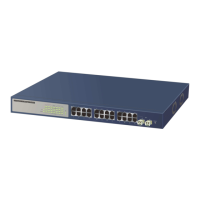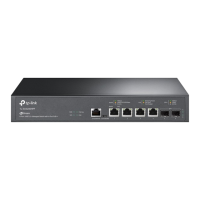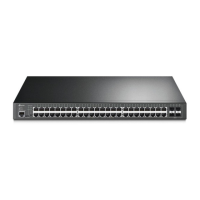deny-low priority —— When the supply power exceeds the power limit, the PD
linked to the port with lower priority will be disconnected.
Command Mode
Global Configuration Mode
Example
Configure the power disconnect method as deny-next-port:
TL-SG3424P(config)# power inline disconnect-method deny-next-port
power profile
Description
The power profile command is used to create a PoE profile for the switch. To
delete the configured PoE profile configuration, please use no power profile
command. PoE Profile is a short cut for the configuration of the PoE port. In a
PoE profile, the PoE status, PoE priority and power limit are configured. You can
specify a PoE profile for each PoE port individually.
Syntax
power profile name [supply {enable | disable} [priority {low | middle | high}
[consumption { power-limit | auto | class1 | class2 | class3 | class4 } ] ] ]
no power profile name
Parameter
name —— The PoE profile name, ranging from 1 to 16 characters. If the name
being assigned contains spaces then put it inside double quotes.
supply —— The PoE status of the port in the profile. By default, the PoE status
is “enable”.
priority —— The PoE priority of the port in the profile. The priority levels include
“high”, “middle” and “low” in descending order. When the supply power exceeds
the system power limit, the PD linked to the port with lower priority will be
disconnected. By default, the PoE priority is “low”.
consumption —— The max power the port in the profile can supply, with five
options: “power-limit”, “auto”, ”class1”, “class2”, “class3” and “class4”.
“Power-limit” indicates you can manually enter a value ranging from 1 to 300.
The value is in the unit of 0.1 watt. For instance, if you want to configure the max
power as 5w, you should enter 50. “Auto” indicates the value is assigned
automatically by the PoE switch. “Class1” represents 4w. “Class2” represents
7w. “Class3” represents 15.4w. “Class4” represents 30w.
166

